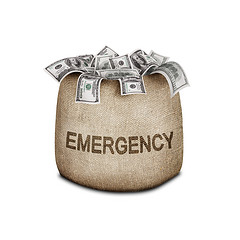Article 125 Financial Tune-Up - Part 5 Build an Emergency Fund As Fast As Possible
Emergency fund is something one should have because it is a necessity. One never knows when an unpleasant surprise will come for a visit. Generally, building an emergency fund is done after the expenses have been tracked, debts have been eliminated and the budget balanced, but it is good to start building it hand in hand with the three aforementioned budget-related tasks. Let’s get started today, shall we?
How much of an emergency fund do we need? First, know that this will take the collective effort of the whole family. The first thing to do is find from the budget how much is the monthly expense. According to the consumer expenditure statistics from the US, the annual expenses amount to $49,638 in 2007. Dividing that by 12 gives the monthly expense as follows: in the table below:

| Number of Months | Cumulative Expenses |
|---|---|
| 1 | $4136.50 |
| 2 | $8273.00 |
| 3 | $12,409.50 |
| 4 | $16,546.00 |
| 5 | $20,682.50 |
| 6 | $24,819.00 |
That certainly sounds like a lot of money but times are uncertain. It is easy to lose a job or to need the roof repaired or a family member can get sick. All these are expensive. Besides if you compare this amount to what one has to save for retirement, this won’t look too much. But still that amount can put off someone who may give up before one can even start. Don‘t be, for we can start small. So let us start building an emergency fund although a partial one. How much do we set aside for this?
We should really have about one to two months’ wages for an emergency fund. That may be a little too much at the start for some, so let us begin building an emergency fund of $1000. I will show you where to get the funds later. Put it in a money market fund where not only it is accessible to you when an emergency occurs but also it will earn more interest than in the bank.
What is a money market? This is the part of the financial market where financial instruments with high liquidity and very short maturities are traded. They consist of certificates of deposits, U.S. Treasury bills, municipal notes, bankers acceptances and federal funds. It is seen as a safe place to park money because it is highly liquid but there are risks. One of the safest are T-Bills but the return is low. So are certificates of deposits with the banks.
Now that you know where to put the money that you build as an emergency fund, the next question is where do we get this money. One way is to look for items in the budget where we can save. In the bottom of this article is a link where you can find how to reduce some items in the budget. You can put the money you save from this in your emergency fund.
Now that we have the first emergency fund of $1000.00 in the money market fund, let’s go further and see if we can build more to reach the two-month requirement of $8,273.00 as mentioned above. You already have $1000.00 and so this means you will only have to save $7273.00 to build your emergency fund to cover two months of expenses. How much will you have to save per month to reach this goal?
How will you do that? Choose the plan of action you want to take. If you want to build your two-month emergency fund in five years, you will have to save $121.22 per month. Now that’s highly doable isn’t it? Maybe you want to do this in half the time, that is in two and half years. Then you will have to put away $242.43 a month.
Cancelling your cable TV and cell phone could get you your emergency fund built up in five years. Depositing your income tax refund, bonus and raise into the emergency fund can make you build it faster. The best thing to do really is to pay yourself first from your pay check. Deposit a certain percentage of it in a savings account every month will help. And you won’t miss it because it is not in the household account.
And once you have your emergency fund, continue building on it. Guard it with your life. Do not use any of it except when there is an emergency. Buying clothes even at half price is not an emergency. Neither is going on a cruise. If you want to have money for a vacation, save for it in another account. Just make sure that the money you worked hard saving will be left intact for the purpose it was built - an emergency fund.
Return from Article 125 Financial Tune-Up - Part 5 Build an Emergency Fund As Fast As Possible to Debt Challenges Home Page for the Disclaimer.
Article 127 Financial Tune-Up - Part 6 Financial Ratios Can Keep One on Track
Article 121 Budget Spreadsheet - Part 3 on Financial Tune-Up
Site Map of Debt Challenges for Easy Navigation Tweet
 Google +1
Google +1
If you want to make any comments or other feedback, please fill in the contact form below so I can send you my email address. This is to avoid spam

=
